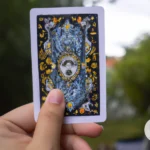Tarot reading is an art form that requires skill and intuition. It is not an exact science, and as such, there are bound to be challenges along the way. As a tarot reader, you may face situations where you misinterpret cards, struggle to stay focused during a reading, or encounter clients who present challenging situations. It’s essential to understand these challenges and learn how to overcome them. In this article, we will explore ten common challenges that tarot readers face and provide practical tips on how to conquer them. By utilizing these tips and tricks, you’ll be able to enhance your tarot skills and provide accurate, insightful readings for yourself and your clients.
Understanding the Challenges

As you delve into the world of intuitive tarot reading, it’s important to understand the common challenges you may face during readings. These challenges include misinterpretation of cards, reading without focus, challenging client situations, and over-reliance on guide books. It’s normal to feel perplexed by these obstacles, but fear not – with the right techniques and mindset, you can overcome them and become a better tarot reader. By developing your intuition and focusing on important aspects such as symbolism and card meanings, you can unlock your potential and provide more insightful readings. To learn more about these topics, be sure to check out our article on the connection between tarot and intuition, tips on understanding tarot card meanings, and explore the various tarot spreads available for intuitive readings.
Misinterpretation of Cards
One of the most common challenges in intuitive tarot reading is the misinterpretation of cards. The interpretation of tarot cards can be challenging, especially for beginners. There can often be a lot of confusion around what each card means, and sometimes the interpretations can be misread or misinterpreted.
It is important to remember that each card has a multitude of possible meanings, and the context in which they appear is crucial to their interpretation. A good way to overcome this challenge is by familiarizing yourself with the symbolism and meanings of the cards. Exploring the symbolism of tarot cards can give you a deeper understanding of the cards and their meanings.
Another way to overcome this challenge is by trusting your intuition. Trusting your intuition is key to interpreting the cards accurately. You may be surprised at how often your first instinctual interpretation of a card is correct. Remember, the tarot is a tool for self-discovery, and there is no right or wrong interpretation.
Keeping a tarot journal can also help with misinterpretation. Write down your interpretations of cards and the context in which they occurred. This will help you track your progress and sharpen your tarot skills over time.
Additionally, it can be helpful to practice with others and get feedback. Joining a tarot group or taking a class can help you gain confidence in your interpretation skills and get feedback from others.
To overcome the challenge of misinterpreting tarot cards, it is important to trust yourself, familiarize yourself with the cards’ symbolism, and practice regularly. By doing so, you can unlock your intuitive potential with tarot and become a more skilled and accurate tarot reader.
| Tip #1 | Familiarize yourself with the symbolism and meanings of the cards |
|---|---|
| Tip #2 | Trust your intuition and go with your first instinct |
| Tip #3 | Maintain a tarot journal to track your progress and sharpen your skills |
| Tip #4 | Practice with others and get feedback in a tarot group or class |
Reading Without Focus
Reading Without Focus is a common challenge in intuitive tarot reading. When your attention is divided, your reading may lack clarity and accuracy. This can happen when you’re distracted or preoccupied with other things, or if you don’t have a clear understanding of the question or issue at hand.
To overcome this challenge, it’s important to:
| 1. Take a deep breath and clear your mind before starting the reading. | Allow yourself to fully concentrate on the reading and let go of any distractions or concerns. |
| 2. Create a quiet and comfortable space for the reading. | Find a place where you feel calm and relaxed, and where you won’t be disturbed. Light a candle or some incense to help create a peaceful atmosphere. |
| 3. Formulate a clear and concise question or issue. | A vague or convoluted question can make it difficult to focus on the reading. Take some time to think about what you want to ask, and try to phrase it in a way that is direct and specific. |
| 4. Use grounding techniques. | Visualize yourself rooted to the ground, or hold a grounding crystal like black tourmaline or hematite. This can help you feel more present and centered during the reading. |
| 5. Practice mindfulness. | Pay attention to your thoughts and senses as you shuffle the cards and lay them out. If you notice your mind wandering, gently bring it back to the present moment. |
Remember, the key to a successful tarot reading is being fully present and focused. By incorporating these tips and techniques, you can improve your concentration and accuracy in your intuitive tarot readings. If you want to learn more techniques to unlock your intuitive potential in tarot reading, you can check out our guide on how to unlock your intuitive potential in tarot.
Challenging Client Situations
As a tarot reader, you may encounter challenging client situations that can make intuitive tarot reading difficult. It’s important to navigate these situations with compassion and professionalism. Here are some common challenging client situations and tips on how to overcome them:
| Challenging Situation | Tips for Overcoming |
| Client is closed off | If a client is not open to receiving guidance, your intuitive abilities will be hindered. Try to establish a rapport with the client before beginning the reading. Ask open-ended questions and actively listen to their responses. Use your intuition to try to discern what they may be struggling with and focus on that area during the reading. |
| Client is overly emotional | When a client is overwhelmed with emotion, it can be challenging to provide them with a clear and concise reading. Take a moment to allow them to collect themselves before starting the reading. Encourage them to take deep breaths and ground themselves. During the reading, try to create a calming environment and use gentle, supportive language. |
| Client is skeptical | Skepticism is a common challenge for tarot readers. Approach a skeptical client with patience and kindness. Share your own experiences with the tarot and encourage them to keep an open mind. Use analogies, metaphors, and stories to help illustrate the meaning of the cards. Focus on providing them with specific insights about their situation that they may find difficult to ignore. |
| Client is fixated on a specific outcome | It’s important to remember that the tarot can provide guidance and insight, but it cannot predict the future with certainty. When a client is fixated on a specific outcome, remind them that the tarot can reveal the potential outcomes of a situation, but ultimately, it is their actions that will determine the final outcome. Encourage them to focus on what they can control and take ownership of their choices. |
Navigating challenging client situations can be difficult for any tarot reader. However, with patience, compassion, and a strong intuition, you can provide valuable insights and guidance to even the most challenging clients.
Over-Reliance on Guide Books
When learning to read the Tarot, it’s natural to rely on guide books to understand the meanings of each card. However, an over-reliance on these books can become a challenge when doing intuitive readings. It’s important to remember that the meanings given in these books are just one interpretation of the cards, and they may not always apply to the specific situation or question at hand. Here are some ways to avoid over-relying on guide books:
- Try to focus on the imagery and symbolism of the card, rather than just the written meaning
- Trust your intuition and allow the cards to speak to you in their own way
- Experiment with different decks and see how the same card can have different meanings in different decks
- Don’t be afraid to deviate from the traditional meanings – sometimes a card can have a completely different meaning based on the question or situation
- Practice makes perfect – the more you practice reading the cards intuitively, the less you will need to rely on guide books
Remember, the Tarot is a tool for self-discovery and personal growth. It’s not about memorizing meanings or following rules, but about tapping into your intuition and connecting with the cards in a way that feels authentic to you. Don’t be afraid to make mistakes or try new things – the more you trust yourself, the more your readings will reflect your unique perspective and insights.
Overcoming the Challenges
Now that we have identified the common challenges that can arise during intuitive tarot reading, it’s time to address them and find ways to overcome them. While the challenges may seem daunting at first, there are some effective techniques and approaches that can help you to develop your skills and enhance your intuitive abilities. In this section, we will explore various strategies and tips that can help you to overcome the challenges and become a more confident and proficient tarot reader. It’s time to delve deeper into the world of tarot and unlock your innate potential.
Listen to Your Intuition
One of the biggest challenges in intuitive tarot readings is trusting your intuition. It can be easy to get caught up in the meaning of the cards, and forget to listen to your inner voice. Here are some tips for tapping into your intuition during a reading:
- Clear your mind: Take a deep breath and clear your mind before beginning the reading. Center yourself and set the intention to listen to your intuition.
- Pay attention to your first impressions: When you draw a card, pay attention to what comes to mind first. It may be a word or image, or just a feeling. Trust that initial intuition, even if it doesn’t seem to make sense at first.
- Notice physical sensations: Your body may also give you clues about the meaning of a card. Pay attention to any feelings, such as tingling or tightness in your chest or stomach.
- Use your senses: Engage your senses to help connect with your intuition. Look at the imagery on the card, listen to any sounds or music around you, and notice any smells or tastes that may be present.
- Don’t overthink: When interpreting a card, try not to overanalyze it. Trust your intuition and let the meaning come to you. If you find yourself getting stuck, take a break or try a different approach.
Remember, your intuition is a powerful tool when it comes to tarot readings. By focusing on your inner voice and learning to trust it, you can become a more confident reader and provide more meaningful guidance to your clients.
Develop a Ritual
Developing a ritual can be a powerful tool in enhancing your tarot reading abilities. With a ritual, you can create a sacred space for your practice and help yourself enter a focused and intuitive state of mind. Here are some steps to get started:
| 1. Choose a space: | Find a quiet and comfortable space where you feel safe and free of distractions. This could be a room in your home or even an outdoor location. |
| 2. Gather your tools: | Gather everything you need for your reading, such as your tarot deck, a journal, and any other items you like to use, such as crystals or candles. |
| 3. Create a ritual: | Create a ritual that works for you. This could include lighting candles, burning sage or incense, or even just taking a few deep breaths to center yourself. |
| 4. Set an intention: | Before you begin your reading, set an intention for what you want to achieve. This could be as simple as asking for guidance, or more specific, like asking for insight into a particular situation. |
| 5. Practice regularly: | Consistency is key when it comes to ritual. Make a habit of creating your ritual every time you do a reading, and you’ll find that it becomes an important part of your practice. |
By developing a ritual, you’ll cultivate a sense of reverence for the tarot and deepen your connection to your intuition. This will help you gain clarity and insight in your readings, and also bring a sense of peace and grounding to your spiritual practice.
Focus on the Question
When it comes to conducting an intuitive tarot reading, focusing on the question is crucial. Without a clear and specific question, the reading can become unfocused and the cards may not provide the clarity you seek. Here are some tips for how to focus on the question:
| 1. Clarify the Question | Before beginning the reading, take some time to clarify the question you are asking. Make sure it is specific, clear and focused, so that you can receive a clear and focused answer. |
| 2. Visualize the Question | Close your eyes and visualize the question you are asking. See it as clearly as you can in your mind’s eye. This will help you to connect with the energy of the question and provide more accurate insights. |
| 3. Stay Focused | During the reading, it’s important to stay focused on the question at hand. Avoid getting sidetracked by other thoughts or distractions, and stay present in the moment. |
| 4. Refocus if Necessary | If you find your mind wandering during the reading or if you lose focus on the question, take a moment to refocus yourself. Take a deep breath and bring your attention back to the question. |
By focusing on the question throughout the reading, you will be able to get a more accurate and meaningful interpretation of the cards. Remember to be patient and trust in the process, and you will receive the clarity you seek.
Keep a Tarot Journal
Keeping a tarot journal is an essential tool for any tarot reader, beginner or advanced. It allows you to reflect on your readings, track your progress, and gain insight into your intuition. Here are some steps to help you get started:
- Choose a Journal: Decide on a journal that resonates with you. It can be a simple notebook or a fancy journal with designs and imagery that inspire you.
- Record Your Readings: After each reading, take notes on your thoughts, feelings, and interpretations. Write down the cards drawn and their positions in the spread. Reflect on how the cards relate to each other, and the overall message they may be conveying.
- Track Your Progress: Look back on your past readings to see how your interpretations have evolved over time. Take note of any patterns or trends that emerge in your readings or in your approach to reading.
- Reflect on Your Intuition: Use your journal to reflect on your intuitive experiences. Record any hunches, insights, or synchronicities that occurred during the reading or afterward. Consider what feelings or images the cards evoke for you.
- Set Goals: Write down your goals for your tarot practice, whether that be to learn a new spread or to deepen your understanding of a particular card. Keep track of your progress toward those goals in your journal.
By keeping a tarot journal, you can gain valuable insights into your readings and your intuition. It is a powerful tool for any tarot reader who wishes to deepen their practice and understanding of the cards.
Practice, Practice, Practice
To become a proficient tarot reader, you must practice, practice, practice. Putting in regular and
Subscribe to Our Newsletter
Sign up to receive the latest news and updates.
- Set aside time: Creating a regular practice schedule can help you stay on track and make tarot reading a habit.
- Choose a focus: When practicing, it can be helpful to focus on a certain area, such as interpreting court cards or reading for relationships.
- Read for others: Practice reading for friends or family members. This will help you learn how to approach different types of questions and situations.
- Try different spreads: Experiment with different tarot spreads to develop your reading style and gain experience with interpreting card positions.
- Reflect on your readings: After each practice session, take time to reflect on the reading. What went well? What could you improve on?
- Get feedback: Ask for feedback from other tarot readers or from the person you read for. This can help you identify areas for improvement and gain insight into your strengths.
- Stay motivated: It’s important to stay motivated and engaged with your tarot practice. Consider setting goals, joining a tarot group, or attending workshops to keep your practice fresh and exciting.
Remember that tarot reading is a skill that takes time and practice to hone. Don’t be too hard on yourself if you make mistakes or don’t understand a card right away. With consistent effort and a willingness to learn, you can become a confident and intuitive tarot reader.
Additional Tips and Tricks
As you continue your journey with intuitive tarot reading, it’s important to keep in mind that there are always new tips and tricks to learn. These helpful techniques can improve your confidence, enhance your readings, and deepen your connection with the Tarot. In this section, we will explore some additional tips and tricks that can help you overcome any remaining challenges and perfect your readings. So, let’s dive in and discover how you can take your intuitive tarot reading skills to the next level!
Clearing and Protecting Your Space
It’s essential to prepare your space before every tarot reading to ensure that you receive clear and accurate intuitive messages. Negative energies and vibrations that linger in your space can influence the reading and cause confusion. Here are some ways to clear and protect your space:
- Salt Bath: Take a salt bath or shower before the reading to cleanse your energy and release any negative feelings or thoughts.
- Smudging: Burn herbs such as sage or palo santo to clear the space of any negative energy. It’s essential to smudge in every corner of the room and around yourself.
- Crystals: Place crystals such as black tourmaline or clear quartz around your space to absorb any negativity and promote positive energy.
- Prayers or Mantras: Say prayers or mantras such as “I am protected by divine energy” or “I only allow positive energy into my space” to set the intention for a positive and productive reading.
It’s important to trust your instincts and figure out what works best for you in terms of clearing and protecting your space. By doing this before every reading, you’ll create a safe and positive environment for both yourself and the client, allowing you to receive clearer and more accurate intuitive messages.
Reading for Yourself
One of the biggest challenges in tarot reading is doing it for yourself. It can be difficult to stay objective and avoid influencing the cards based on what you want or fear. Here are some tips for effective self-readings:
| Tip | Explanation |
|---|---|
| Take a Break | Before starting your reading, take some time to center yourself and clear your mind. This will help you approach the reading with a calm and neutral mindset. |
| Focus on the Question | Make sure your question is clear and specific. This will help you avoid muddying the message with unrelated thoughts or anxieties. Use our Focus on the Question tip from the previous section to help. |
| Be Honest | Take an honest look at what the cards are telling you. Try to put aside any preconceptions or biases you may have and be open to unexpected answers. |
| Use a Spread | Choose a spread that is designed for self-readings. This can help provide structure and guidance to your reading, making it easier to stay focused and objective. |
| Journal Your Reading | After your reading, write down your interpretation of the cards and how they relate to your question. This can help you gain clarity and insight into the message the cards are trying to convey. |
Remember that it can be challenging to read for yourself, but with practice and patience, you can overcome this obstacle. Don’t be afraid to seek outside guidance or a second opinion if you feel stuck or unsure about your interpretation.
Using Your Imagination
When it comes to intuitive tarot reading, using your imagination can be a helpful tool to unlock deeper meanings and symbolism within the cards. One way to do this is by allowing your mind to wander and explore the imagery within the cards, using your imagination to connect the dots and piece together a story.
Visualization Exercises: A great way to tap into your imagination is through visualization exercises. Take a few minutes to close your eyes and envision the cards in front of you. Imagine stepping into the card and exploring the scenery, connecting with the characters, and feeling the emotions that are present. This can help to uncover hidden meanings and insights that you may have overlooked previously.
Free Association: Another technique for using your imagination is through free association. Take a card and write down the first few words or images that come to mind. Then, continue to brainstorm related ideas and emotions until you have a cohesive story or interpretation. This can help to spark your intuition and connect with the cards on a deeper level.
Emotional Connection: Finally, using your imagination can be helpful in making an emotional connection to the cards. Allow yourself to feel the emotions that come up when you look at the card, even if they seem unrelated or confusing at first. This can bring a new level of understanding and insight to your readings, as well as help you connect with your clients on a more empathetic level.
Using your imagination can be a powerful tool in intuitive tarot reading, helping you to unlock hidden meanings and explore new facets of the cards. Incorporating visualization exercises, free association, and emotional connection can all aid in developing your intuitive abilities and connecting with the cards on a deeper level.
Conclusion
In conclusion, intuitive tarot reading can be a challenging but rewarding practice. While the misinterpretation of cards, reading without focus, challenging client situations, and over-reliance on guide books can hinder the process, there are various ways to overcome these obstacles.
By listening to your intuition and developing a ritual, you can establish a deeper connection with the cards. Additionally, focusing on the question and keeping a tarot journal can improve your accuracy and understanding.
However, it’s important to remember that practice makes perfect. Don’t be discouraged if you encounter challenges along the way, as consistent practice can help you sharpen your skills.
Furthermore, incorporating additional tips and tricks such as clearing and protecting your space, reading for yourself, and using your imagination can enhance your sessions.
Overall, the key to a successful tarot reading is to not only understand the meanings of the cards, but also to trust your instincts and approach each reading with an open mind. With dedication and perseverance, anyone can become a skilled intuitive tarot reader.
Frequently Asked Questions
What should I do if I get a negative or scary card?
Don’t panic! Take a deep breath and try to stay calm. Look at other cards in the spread to see if they provide a more positive context. Also, remember that the cards are not set in stone and can be changed with your actions and decisions.
How can I make sure I stay focused while doing a reading?
One way is to develop a ritual before each reading, such as lighting a candle or reciting a prayer. Also, try to eliminate distractions and set aside a specific time and place for your readings.
What if the client asks a question that I don’t feel comfortable answering?
It’s important to set boundaries and communicate them clearly to your client. Let them know if there are certain topics you prefer not to discuss, or offer to refer them to another reader who may be able to better assist them.
How often should I cleanse my tarot deck?
It’s up to personal preference, but some readers like to cleanse their decks after each reading or once a week. You can use methods such as smudging with sage or palo santo, placing them in sunlight or moonlight, or using sound vibration with singing bowls or bells.
What if I can’t seem to connect with a particular deck?
Don’t be afraid to try different decks until you find one that resonates with you. It’s also important to spend time with a new deck before using it for readings, such as holding each card and familiarizing yourself with the imagery.
Can I use tarot cards for predictive readings?
While tarot cards can provide insight into potential future outcomes, it’s important to remember that the future is not set in stone and can be influenced by your actions and decisions. Focus on using the cards to gain insight into the present moment and any potential obstacles or opportunities.
Is it possible to do a tarot reading for someone who is not present?
Yes, this is known as a “distance reading.” However, it’s important to have the client’s permission beforehand and to establish clear communication channels, such as email or video chat.
Can I use tarot cards for decision-making?
Yes, tarot cards can provide valuable insight into different options and potential outcomes. However, it’s important to remember that ultimately the decision is up to you and the cards should be used as a tool for guidance, rather than a substitute for your own free will.
Are there any situations where tarot readings are not appropriate?
It’s important to use discretion and ethical considerations when offering tarot readings. Avoid doing readings for someone who is in a highly emotional or vulnerable state, or if you feel a conflict of interest, such as a close friend or family member.
How can I ensure that my readings are ethical and responsible?
One way is to establish clear boundaries and communication with your clients, such as informing them of the limitations of the tarot and your role as a reader. Also, make sure to respect confidential information and avoid offering medical or legal advice.










